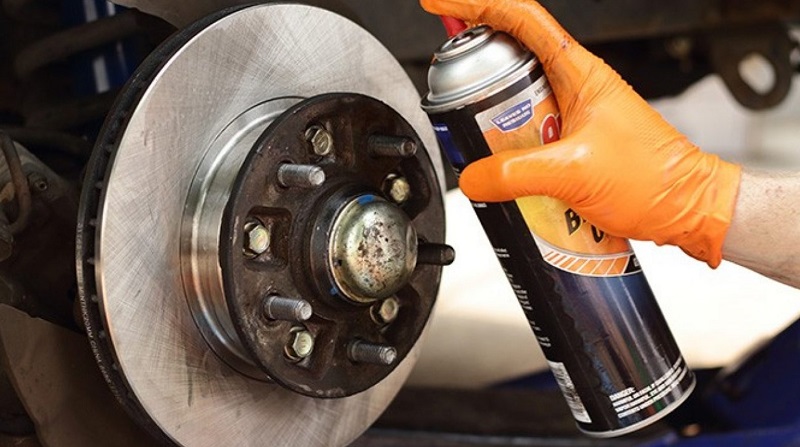One of the most important components of any passenger vehicle is its disc braking system. To keep it simple, most of these disc-braking systems include a master cylinder, calipers, brake pads, and brake rotors. Brake rotors are what we will concentrate on in this article, in particular, how to maintain and clean the rotors.
Keeping the rotors clean will extend the life of your brake pads and ensure that the braking system will do what it is supposed to do, help slow down or stop your vehicle. When you depress the brake pedal, the brake pads are squeezed tightly against the rotors and the friction created slows the vehicle. Brake dust and debris will build up on the rotors as the brake pads wear, which can cause all sorts of different braking problems. The smoother and cleaner the rotors are, the better the brakes will work. Rotors should be cleaned on a regular basis to remove any rust or debris buildup and keep their surface as smooth as possible.
3 Different Ways to Clean Brake Rotors
No matter which of these three ways you use, you will need to first park the vehicle on a level surface, apply the parking brake, jack the wheel up off of the ground (slightly loosen the lug nuts before jacking), and remove the wheel to expose the rotor. Always wear protective gloves and eyewear when cleaning your rotors.
Cleaning Rotors with Brake Cleaner
Brake parts cleaners usually come in an aerosol can with a nozzle extender to help apply it to hard-to-reach areas. >>> Find some great options on Amazon There are basically two types of brake cleaners on the market: older style cleaners are chlorinated, newer versions are non-chlorinated. The chlorinated versions are non-flammable, the non-chlorinated versions are. The newer non-chlorinated versions, which contain acetone, an irritant that is also flammable, are said to be “environmentally friendly”, a scientific misnomer, because all of these cleaners are toxic, and you should avoid direct contact with your skin or eyes.
Once the wheel has been removed and the rotor exposed, place a metal pan under the rotor to catch any runoff and debris. Some people suggest using a towel for this, but a pan is better. Begin spraying at the top of the rotor and allow the cleaner to flow downward into the pan. Liberally spray the cleaner on the surface of the rotor and along the grove on the rotor’s edge. After a few minutes of dwell time, use a microfiber towel to wipe the surface of the rotor.
Some of the better brake cleaners available are made by CRC, Gunk, Permatex, Apel, and 3M. If you want to watch a YouTube video about cleaning rotors with a brake cleaner, this is a good one to watch:
Cleaning Rotors with Dish Soap and Warm Water
When using dish soap and warm water, you will also want to have a soft nylon brush to loosen any debris. Mix a solution of warm water and dish soap in one spray bottle, and fill a second spray bottle with warm water only. Place a pan or towel on the ground under the rotor that you are cleaning to catch the runoff. Liberally apply the soap and water to the rotor. Use the nylon brush to work the solution around the rotor (don’t forget to address the edge grove). Spray the rotor with the soap solution a second time if necessary and then rinse the rotor with the clear water. Wipe the rotor with a microfiber cloth.
If you want to watch a YouTube video about cleaning rotors with dish soap and warm water, this is a good example:
Cleaning Rotors with White Vinegar

When using vinegar, use it full strength, don’t mix it with water. Put the vinegar in one spray bottle and warm water in the other. Vinegar is a safe choice that is mildly acidic and great for removing rust. Spray the rotor with the vinegar, allow it to dwell, then rinse the rotor with the warm water and dry it with a microfiber cloth. >>>> Find great options on Amazon.
A better way when using vinegar is to remove the rotor from the wheel assembly. In order to remove the rotor you will have to loosen and remove the brake calipers first. Place the rotor in an oil change pan, and pour in enough vinegar to completely cover the rotor. Allow the rotor to sit in the vinegar overnight, then simply remove it from the pan and wipe the surfaces with your microfiber cloth to remove rust and debris.
For one of the better YouTube videos for using white vinegar, watch this one:
Cleaning your vehicle’s rotors is a simple task that can be accomplished in one afternoon. If you have jack stands and can remove all four wheels at the same time, the job goes even faster. The benefits are that your vehicle will have better stopping power, there will be less wear and tear on your brake pads, and a longer lifespan for your brake rotors.

